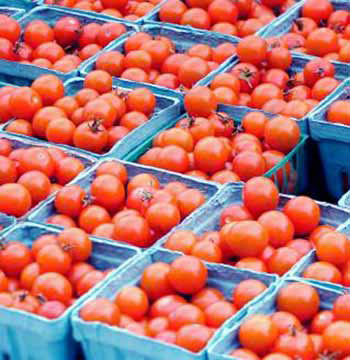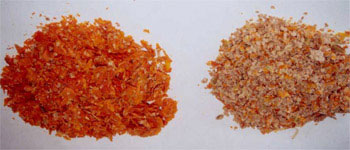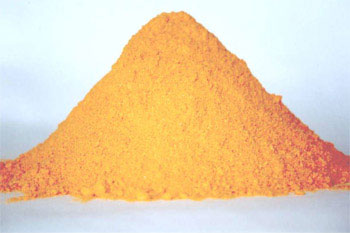PRODUCTS, EXTRACTS AND BY-PRODUCTS OF TOMATO AS NEW FOOD INGREDIENTS
|
Description |

In Spain, during the year 2019, 3000 tonnes of tomatoes were allocated for processing.
Fruits and vegetables processes generates large amounts of solid and liquid waste; the total or partial recovery of these wastes would bring economic, social and environmental benefits.
The byproduct of tomato processing consists of the skin and the seeds. Tomato skins are rich in fiber and lycopene. The incidence of prostate cancer in men, and breast cancer in women may be reduced by the intake of lycopene and dietary fiber has different beneficial properties. The seeds on the other hand are rich in unsaturated fatty acids that prevent cardiovascular disease.
A research group of the Department of Nutrition and Food Science of the Complutense University of Madrid offers its knowledge on the raw material (fresh fruit), commercial products derived (concentrates, sauces, juices, etc.), extracts (powder and oleoresin) And by-products (skins and seeds), which have shown that the potential of tomato components (products, extracts and byproducts) is of great nutritional and technological interest (due to its fiber, lycopene and bioactive compounds content) in the formulation of different foods for consumption To produce products of high nutritional value with the potential application of nutritional and health claims.
|
How does it work |
Tomato is one of the most important vegetables in terms of consumption, employment generation and wealth. In 2020, 38,282 million kilos of industrial tomatoes were produced in the world. This represents an increase of 2.4% compared to 2019. The four main producing countries are: the United States, followed by Italy, China and Spain. In Europe, tomato production for industry is mainly concentrated in the Mediterranean area (Italy and Spain, followed by Portugal and Greece) and within Spain in the south, Extremadura (with more than 80% of national production) and Andalusia, followed by Murcia and Navarre. The processing of fruits and vegetables generates large amounts of solid and liquid waste; the total or partial recovery of these wastes would imply economic, social and environmental advantages. The byproduct of tomato processing consists of the skin and the seeds. Tomato skins are rich in fiber and lycopene. The incidence of prostate cancer in men and breast cancer in women can be reduced by ingestion of lycopene and dietary fiber has different beneficial properties. The seeds on the other hand are rich in unsaturated fatty acids that prevent cardiovascular disease.

Fractions of skins and seeds.
The research group has experience and concrete results and has developed laboratory and pilot plant trials in relation to:
- The most effective drying procedure to ensure that the tomato by-product is stable.
- Knowledge of the chemical composition of this dried by-product, as well as its fractions (skins and seeds).
- The most economical and simple method of separating and conditioning the fractions that make up the tomato byproduct: skins and seeds.
- Evaluation of different methods of extracting and obtaining useful components from the by-product.
- The results obtained from formulating new foods using as an ingredient of the by-product, or some fraction or component, such as: enriched tomato derivatives, pasta making and sweets.
- The ability to evaluate the nutritional properties of the new food ingredients.
- The ability to evaluate the potential nutrition and health claims to be used in food labelling.
|
Advantages |

Tomato fiber
For the development of food products with greater added value it is necessary to improve the processing technologies as well as the use of potentially beneficial components for health. The food industry must face the important problem of accumulation, handling and disposal of waste, and there is a growing demand for its conversion into useful byproducts. Regulation (EC) 1924/2006 on nutritional claims of foods requires that any statement (within licenses) is based on verified and actual scientific evidence. It is for this reason that the correct characterization of the products, extracts and by-products is of vital importance for its possible commercialization. The tomato residue represents at least 4% of the fruit weight. Taking into account that In Spain, during 2019, around 3,000 million kilos of tomatoes are produced for industry, a quantity that has remained stable from 2014-2015. The 4% of this result is an average value of 120 mt of tomato residues, a quantity that reveals the great importance of the same in the industries of the sector and justifies the need to find a utility for this waste. The previous experience of the research group reveals that the tomato residue is rich in nutrients and could be used as a potential source of fiber, protein or fat, so that its application will provide an extra benefit for the industry and at the same time reduce the problem of disposal of such waste.
|
Where has it been developed |
To ensure success in this field, public and private collaboration is necessary. The Department of Nutrition and Food Science of the Universidad Complutense de Madrid is known for its work on the agricultural, technological and nutritional characteristics of tomatoes and has previously collaborated with national and international organizations such as the Californian Association of Tomato Processors and AGRUCON (Spanish Grouping of Canned Vegetable Manufacturers), as well as other national research centers (CTAEX, Badajoz) and foreigners (UC Davis, USA, USDA Albany, USA, CTCPA, France, etc.) where part of the investigations have been developed. Dr. Cámara is the representative in Spain-UCM of the proposal EU-AWAKENING. Integrated Waste and packaging reduction in the fruits and vegetables value chain. Call: H2020-LC-GD-2020, European Green Deal.
|
And also |
We look for companies or associations of entrepreneurs with which to establish a technical cooperation that leads us to expand the research on the use of products extracts and tomato byproducts and their functional and nutritional characteristics. Collaboration between industries producing tomato derivatives (providing the raw material) and Technological Centers or Companies that develop new products would be desirable. The purpose of this collaboration is the application of the knowledge acquired to obtain new commercial products with high added value. The research group offers its knowledge and experience in the field of composition, evaluation of nutritional properties and technological aptitude of vegetable products in general and tomato in particular.
|
Contact |
|
© Office for the Transfer of Research Results – UCM |
|
PDF Downloads |
|
Classification |
|
Responsible Researcher |
Montaña Cámara Hurtado: mcamara@farm.ucm.es
Department: Nutrition and Food Science Department
Faculty: Pharmacy


